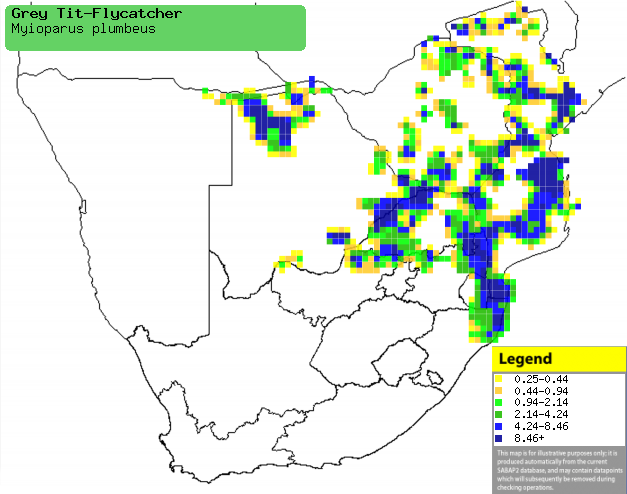|
Myioparus plumbeus (Grey
tit-flycatcher, Fan-tailed flycatcher)
Waaierstertvlieëvanger [Afrikaans];
Mees-vliegenvanger [Dutch]; Gobemouche mésange [French]; Meisenschnäpper
[German]; Para-moscas-de-leque [Portuguese]
Life
> Eukaryotes >
Opisthokonta
> Metazoa (animals) >
Bilateria >
Deuterostomia > Chordata >
Craniata > Vertebrata (vertebrates) > Gnathostomata (jawed
vertebrates) > Teleostomi (teleost fish) > Osteichthyes (bony fish) > Class:
Sarcopterygii (lobe-finned
fish) > Stegocephalia (terrestrial
vertebrates) > Tetrapoda
(four-legged vertebrates) > Reptiliomorpha > Amniota >
Reptilia (reptiles) >
Romeriida > Diapsida > Archosauromorpha > Archosauria >
Dinosauria
(dinosaurs) > Saurischia > Theropoda (bipedal predatory dinosaurs) >
Coelurosauria > Maniraptora > Aves
(birds) > Order: Passeriformes
> Family: Muscicapidae
Distribution and habitat
Occupies patches across sub-Saharan Africa, from Senegal to
Ethiopia south to southern Africa. Here it is localised and uncommon, occurring
in Mozambique, Zimbabwe, north-eastern South Africa, northern Botswana and the
Caprivi Strip (Namibia). It generally prefers miombo (Brachystegia)
woodland, bushveld, riverine forest and the edge of lowland evergreen forest.
|
 |
|
Distribution of Grey tit-flycatcher in southern Africa,
based on statistical smoothing of the records from first SA Bird Atlas
Project (©
Animal Demography unit, University of
Cape Town; smoothing by Birgit Erni and Francesca Little). Colours range
from dark blue (most common) through to yellow (least common).
See here for the latest distribution
from the SABAP2. |
Predators and parasites
It has been recorded as prey of
Accipiter minullus
(Little sparrowhawk).
Food
It mainly eats insects doing most of its foraging in the
tree canopy, gleaning prey from leaves and branches. The following food items have been recorded
in its diet:
Breeding
- The nest is built by both sexes, consisting of a thin-walled cup built of
roots, fine grass, shredded bark and lichens, lined with feathers and
flowers. It is typically placed in a cavity in a tree, either natural or
made by a woodpecker or
barbet.
- Egg-laying season is from August-January, peaking from October-December.
- It lays 2-3 dull white eggs, thickly spotted with olive and brown.
Threats
Not threatened.
References
-
Hockey PAR, Dean WRJ and Ryan PG 2005. Roberts
- Birds of southern Africa, VIIth ed. The Trustees of the John Voelcker
Bird Book Fund, Cape Town.
|
